Digs & Discoveries
Sailing in Sumer
By BENJAMIN LEONARD
Friday, June 10, 2022
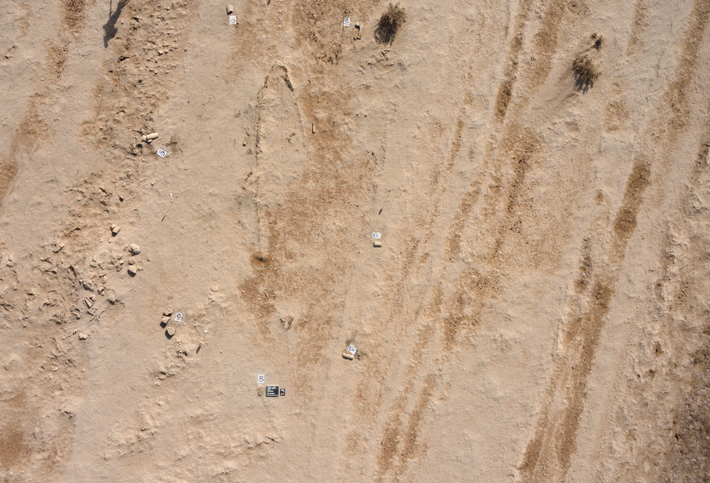 An Iraqi-German team recently excavated the remnants of an ancient boat that was exposed by erosion in 2018 near the Sumerian city of Uruk in southern Iraq. The boat, which measures 23 feet long and up to 4.5 feet wide, was found on the city’s outskirts in an area once covered by fields, canals, and small settlements. The vessel sank around 4,000 years ago near the bank of a river that has long since silted up. Although the organic material used to construct the boat—likely wood, reeds, or palm leaves—has completely decayed, the material left clear impressions in a surviving layer of bitumen that was applied to the boat as waterproofing. Researchers carefully documented the excavation of the fragile find before moving the vessel’s remnants to the Iraq Museum in Baghdad for conservation and study. To see an image of the boat's excavation, click here.
An Iraqi-German team recently excavated the remnants of an ancient boat that was exposed by erosion in 2018 near the Sumerian city of Uruk in southern Iraq. The boat, which measures 23 feet long and up to 4.5 feet wide, was found on the city’s outskirts in an area once covered by fields, canals, and small settlements. The vessel sank around 4,000 years ago near the bank of a river that has long since silted up. Although the organic material used to construct the boat—likely wood, reeds, or palm leaves—has completely decayed, the material left clear impressions in a surviving layer of bitumen that was applied to the boat as waterproofing. Researchers carefully documented the excavation of the fragile find before moving the vessel’s remnants to the Iraq Museum in Baghdad for conservation and study. To see an image of the boat's excavation, click here.
Dignity of the Dead
By DANIEL WEISS
Friday, June 10, 2022
 While investigating aboveground mausoleums known as chullpas in the Chincha Valley, on the southern coast of Peru, archaeologists have discovered 192 instances of a previously unknown approach among the area’s Indigenous people to honoring the dead: human vertebrae threaded onto reed posts. From around A.D. 1000 to 1400, the region was controlled by the Chincha Kingdom, which formed an alliance with the Inca Empire and was incorporated into it in the fifteenth century. When Spanish colonists arrived in the sixteenth century, they looted the valley’s chullpas, searching for silver and gold.
While investigating aboveground mausoleums known as chullpas in the Chincha Valley, on the southern coast of Peru, archaeologists have discovered 192 instances of a previously unknown approach among the area’s Indigenous people to honoring the dead: human vertebrae threaded onto reed posts. From around A.D. 1000 to 1400, the region was controlled by the Chincha Kingdom, which formed an alliance with the Inca Empire and was incorporated into it in the fifteenth century. When Spanish colonists arrived in the sixteenth century, they looted the valley’s chullpas, searching for silver and gold.
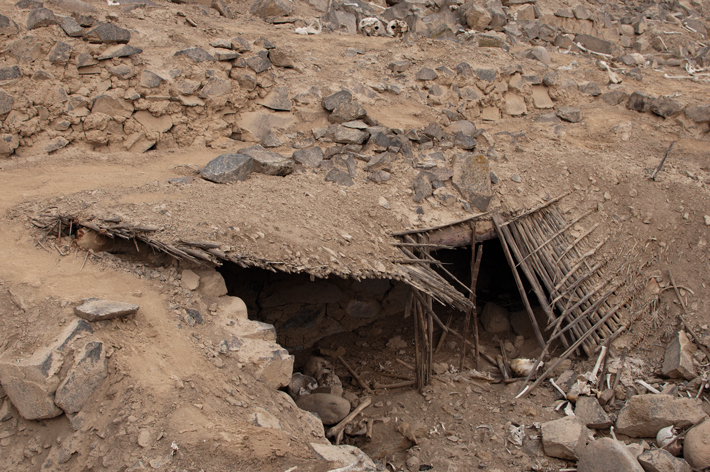 Using radiocarbon dating, the researchers have determined that the individuals whose vertebrae were threaded onto posts likely died between 1520 and 1550, and that the reeds the posts were made of were harvested over the subsequent four decades. According to Jacob Bongers, an archaeologist at the University of East Anglia, the practice appears to have been an attempt by the valley’s Indigenous people to restore the integrity of their ancestors’ remains, which had been buried in textile bundles that were disturbed by looters. “We think these local people found that many of the bundles had been looted and bones had been scattered on the tomb floors,” Bongers says. “So you had people going back into these tombs and attempting to reconstruct their dead by putting the vertebrae on posts.” To see an image of several other chullpas in the Chincha Valley, click here.
Using radiocarbon dating, the researchers have determined that the individuals whose vertebrae were threaded onto posts likely died between 1520 and 1550, and that the reeds the posts were made of were harvested over the subsequent four decades. According to Jacob Bongers, an archaeologist at the University of East Anglia, the practice appears to have been an attempt by the valley’s Indigenous people to restore the integrity of their ancestors’ remains, which had been buried in textile bundles that were disturbed by looters. “We think these local people found that many of the bundles had been looted and bones had been scattered on the tomb floors,” Bongers says. “So you had people going back into these tombs and attempting to reconstruct their dead by putting the vertebrae on posts.” To see an image of several other chullpas in the Chincha Valley, click here.
The Great Maize Migration
By BENJAMIN LEONARD
Friday, June 10, 2022
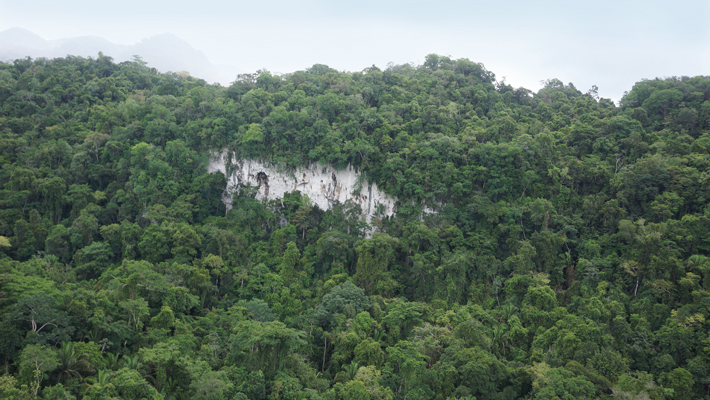
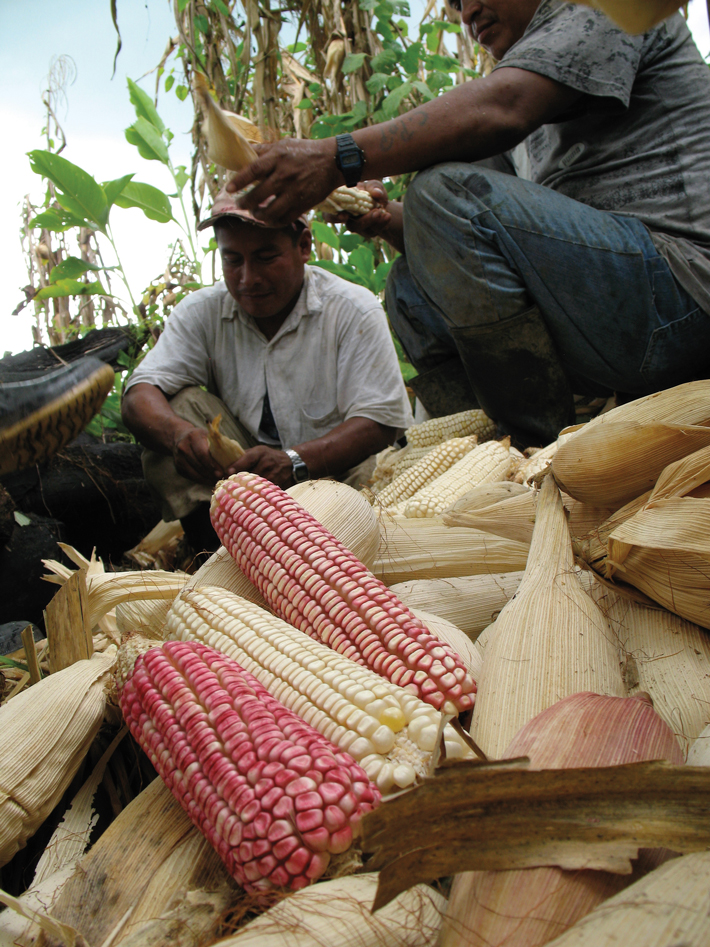 According to a new study, more than half of the modern Maya genome is derived from ancient populations who migrated to the Yucatán Peninsula from southern Central America and South America at least 5,600 years ago. A team led by archaeologist Keith Prufer of the University of New Mexico, geneticist David Reich of Harvard University, and archaeologist Douglas Kennett of the University of California, Santa Barbara, analyzed DNA from human remains recovered from two rock shelters in southern Belize. They discovered that a group of the individuals whose remains were radiocarbon dated to between 5,600 and 4,000 years ago are ancestors of present-day Chibchan-speaking populations that live between Costa Rica and northern Colombia. “These people moved into the area in fairly small numbers over a period of perhaps five hundred to one thousand years and mixed with local populations,” Kennett says.
According to a new study, more than half of the modern Maya genome is derived from ancient populations who migrated to the Yucatán Peninsula from southern Central America and South America at least 5,600 years ago. A team led by archaeologist Keith Prufer of the University of New Mexico, geneticist David Reich of Harvard University, and archaeologist Douglas Kennett of the University of California, Santa Barbara, analyzed DNA from human remains recovered from two rock shelters in southern Belize. They discovered that a group of the individuals whose remains were radiocarbon dated to between 5,600 and 4,000 years ago are ancestors of present-day Chibchan-speaking populations that live between Costa Rica and northern Colombia. “These people moved into the area in fairly small numbers over a period of perhaps five hundred to one thousand years and mixed with local populations,” Kennett says.
This migration coincided with the introduction to the Yucatán of improved varieties of maize. Maize had originated in southwestern Mexico around 9,000 years ago and was dispersed to South America before being fully domesticated. It was then reintroduced to the north. Isotope analysis of the remains of the people found in the rock shelters revealed that their consumption of maize jumped significantly starting 4,700 years ago. Along with new maize varieties, and possibly other crops such as manioc and chilies, Kennett explains, the migrants likely brought horticultural knowledge that eventually led to the development of intensive agriculture in the Maya region. “By four thousand years ago, corn was a staple grain in their diet,” he says. To see an image of excavations at one of the rock shelters in Belize, click here.
Mummy Makers
By BENJAMIN LEONARD
Friday, June 10, 2022
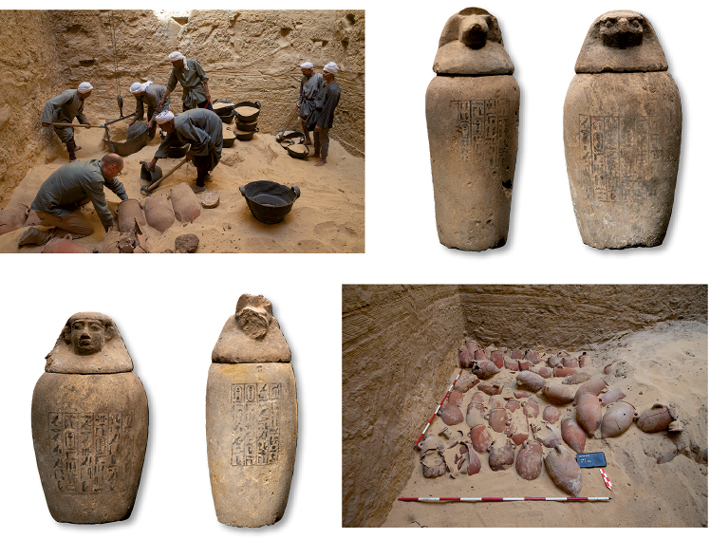 On the western side of the ancient necropolis of Abusir, a team of archaeologists led by Miroslav Bárta of Charles University has unearthed the largest cache of embalming equipment ever found in Egypt. More than 370 vessels were buried in clusters during the second half of the sixth century B.C. in a 46-foot-deep shaft, which seems to be associated with an adjacent, as-yet-unexcavated tomb.
On the western side of the ancient necropolis of Abusir, a team of archaeologists led by Miroslav Bárta of Charles University has unearthed the largest cache of embalming equipment ever found in Egypt. More than 370 vessels were buried in clusters during the second half of the sixth century B.C. in a 46-foot-deep shaft, which seems to be associated with an adjacent, as-yet-unexcavated tomb.
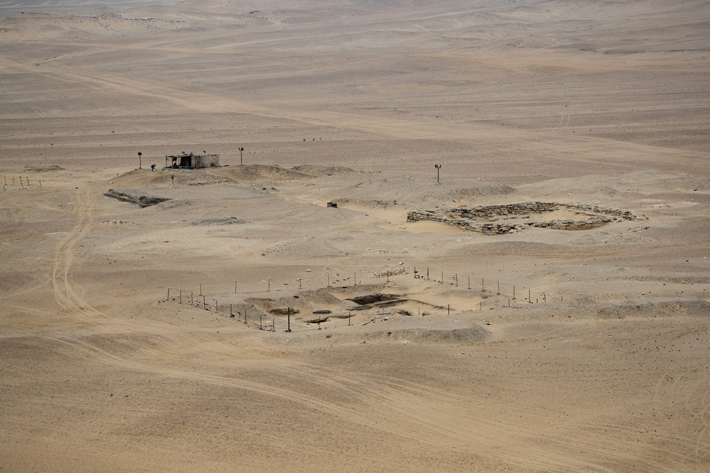 In the top layer of the cache, the researchers discovered four canopic jars, which were typically used to store the embalmed viscera and organs that were removed during mummification. “These jars should have been buried with the deceased in his tomb, but they were discovered clean and empty in the cache,” says Egyptologist Jiří Janák of Charles University. “We are still trying to determine whether they were copies, used only symbolically, or used for storage during the embalming process.” Inscriptions on the jars identify the deceased, Wahibre-mery-Neith, who is likely interred in the unopened tomb, and his mother, Lady Irturu. Janák suggests Wahibre-mery-Neith and Irturu may have been relatives of two individuals buried in a tomb within 165 feet of the embalming cache. He says this may be evidence that this area of Abusir was an elite family cemetery. For additional images, click here.
In the top layer of the cache, the researchers discovered four canopic jars, which were typically used to store the embalmed viscera and organs that were removed during mummification. “These jars should have been buried with the deceased in his tomb, but they were discovered clean and empty in the cache,” says Egyptologist Jiří Janák of Charles University. “We are still trying to determine whether they were copies, used only symbolically, or used for storage during the embalming process.” Inscriptions on the jars identify the deceased, Wahibre-mery-Neith, who is likely interred in the unopened tomb, and his mother, Lady Irturu. Janák suggests Wahibre-mery-Neith and Irturu may have been relatives of two individuals buried in a tomb within 165 feet of the embalming cache. He says this may be evidence that this area of Abusir was an elite family cemetery. For additional images, click here.
A Civil War Bomb
By JASON URBANUS
Friday, June 10, 2022
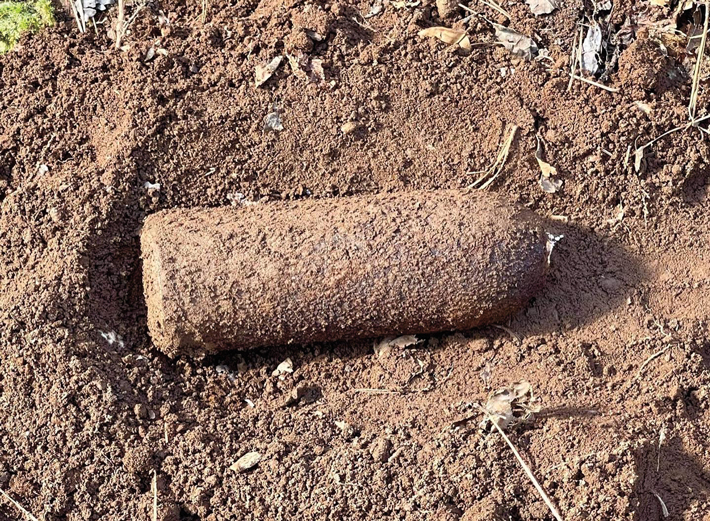
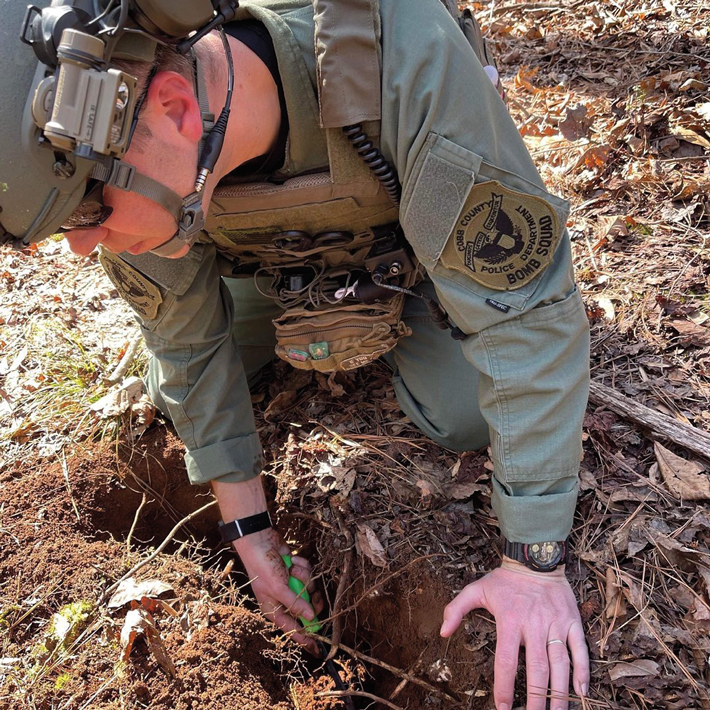 A 158-year-old piece of unexploded ordnance was discovered just 10 inches underground during an archaeological survey at the site of a key Civil War battle in Georgia. The survey was conducted prior to the creation of a new hiking trail through Kennesaw Mountain National Battlefield Park, where Union and Confederate forces clashed between June 19 and July 2, 1864. The 10-pound cylindrical projectile has a curved nose and is of a type mainly used by the Union Army. Named a Parrott shell after Captain Robert Parker Parrott, who invented the cannon from which it was fired, the ordnance was much more accurate and deadly than traditional round cannon shot. The shell was designed to explode upon impact, but its percussion fuse apparently failed to ignite. Nevertheless, it is believed to still be live and may be slated for a controlled detonation.
A 158-year-old piece of unexploded ordnance was discovered just 10 inches underground during an archaeological survey at the site of a key Civil War battle in Georgia. The survey was conducted prior to the creation of a new hiking trail through Kennesaw Mountain National Battlefield Park, where Union and Confederate forces clashed between June 19 and July 2, 1864. The 10-pound cylindrical projectile has a curved nose and is of a type mainly used by the Union Army. Named a Parrott shell after Captain Robert Parker Parrott, who invented the cannon from which it was fired, the ordnance was much more accurate and deadly than traditional round cannon shot. The shell was designed to explode upon impact, but its percussion fuse apparently failed to ignite. Nevertheless, it is believed to still be live and may be slated for a controlled detonation.
The Battle of Kennesaw Mountain witnessed some of the bloodiest fighting of the Atlanta Campaign, as Union troops under General William Tecumseh Sherman swept across the South. Although Sherman was dealt a tactical defeat at Kennesaw Mountain, suffering 3,000 casualties, his progress was unimpeded and he took the strategic Confederate city of Atlanta two months later
Advertisement
Advertisement
IN THIS ISSUE
Digs & Discoveries
Save the Dates
Spice Hunters
Suspicious Silver
A Civil War Bomb
The Great Maize Migration
Mummy Makers
Dignity of the Dead
Sailing in Sumer
Speak, Memories
The Maya Count Begins
Hail to the Chief
Made in China
Off the Grid
Around the World
Notre Dame’s dignitaries, Bronze Age daggers, the world’s biggest quake, a lost snowshoe, and 50,000-year-old Australians
Artifact
A portable connection
Advertisement

Recent Issues
-
 May/June 2024
May/June 2024
-
 March/April 2024
March/April 2024
-
 January/February 2024
January/February 2024
-
 November/December 2023
November/December 2023
-
 September/October 2023
September/October 2023
-
 July/August 2023
July/August 2023
-
 May/June 2023
May/June 2023
-
 March/April 2023
March/April 2023
-
 January/February 2023
January/February 2023
-
 November/December 2022
November/December 2022
-
 September/October 2022
September/October 2022
-
 July/August 2022
July/August 2022
-
 May/June 2022
May/June 2022
-
 March/April 2022
March/April 2022
-
 January/February 2022
January/February 2022
-
 November/December 2021
November/December 2021
-
 September/October 2021
September/October 2021
-
 July/August 2021
July/August 2021
-
 May/June 2021
May/June 2021
-
 March/April 2021
March/April 2021
-
 January/February 2021
January/February 2021
-
 November/December 2020
November/December 2020
-
 September/October 2020
September/October 2020
-
 July/August 2020
July/August 2020
-
 May/June 2020
May/June 2020
-
 March/April 2020
March/April 2020
-
 January/February 2020
January/February 2020
-
 November/December 2019
November/December 2019
-
 September/October 2019
September/October 2019
-
 July/August 2019
July/August 2019
-
 May/June 2019
May/June 2019
-
 March/April 2019
March/April 2019
-
 January/February 2019
January/February 2019
-
 November/December 2018
November/December 2018
-
 September/October 2018
September/October 2018
-
 July/August 2018
July/August 2018
-
 May/June 2018
May/June 2018
-
 March/April 2018
March/April 2018
-
 January/February 2018
January/February 2018
-
 November/December 2017
November/December 2017
-
 September/October 2017
September/October 2017
-
 July/August 2017
July/August 2017
-
 May/June 2017
May/June 2017
-
 March/April 2017
March/April 2017
-
 January/February 2017
January/February 2017
-
 November/December 2016
November/December 2016
-
 September/October 2016
September/October 2016
-
 July/August 2016
July/August 2016
-
 May/June 2016
May/June 2016
-
 March/April 2016
March/April 2016
-
 January/February 2016
January/February 2016
-
 November/December 2015
November/December 2015
-
 September/October 2015
September/October 2015
-
 July/August 2015
July/August 2015
-
 May/June 2015
May/June 2015
-
 March/April 2015
March/April 2015
-
 January/February 2015
January/February 2015
-
 November/December 2014
November/December 2014
-
 September/October 2014
September/October 2014
-
 July/August 2014
July/August 2014
-
 May/June 2014
May/June 2014
-
 March/April 2014
March/April 2014
-
 January/February 2014
January/February 2014
-
 November/December 2013
November/December 2013
-
 September/October 2013
September/October 2013
-
 July/August 2013
July/August 2013
-
 May/June 2013
May/June 2013
-
 March/April 2013
March/April 2013
-
 January/February 2013
January/February 2013
-
 November/December 2012
November/December 2012
-
 September/October 2012
September/October 2012
-
 July/August 2012
July/August 2012
-
 May/June 2012
May/June 2012
-
 March/April 2012
March/April 2012
-
 January/February 2012
January/February 2012
-
 November/December 2011
November/December 2011
-
 September/October 2011
September/October 2011
-
 July/August 2011
July/August 2011
-
 May/June 2011
May/June 2011
-
 March/April 2011
March/April 2011
-
 January/February 2011
January/February 2011
Advertisement






